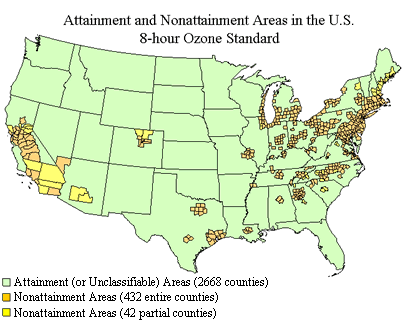 The Environmental
Protection Agency (EPA) released a list yesterday of U.S. counties that need
to come into compliance for amounts of ozone in the atmosphere at ground levels.
The policy changes are part of new regulations for acceptable ozone exposure
over an 8-hour period, intended to protect human health. Ozone exposure raises
the risk of asthma and other respiratory illnesses in humans. The announcement
indicates that millions of people in about 500 counties are considered at risk.
The Environmental
Protection Agency (EPA) released a list yesterday of U.S. counties that need
to come into compliance for amounts of ozone in the atmosphere at ground levels.
The policy changes are part of new regulations for acceptable ozone exposure
over an 8-hour period, intended to protect human health. Ozone exposure raises
the risk of asthma and other respiratory illnesses in humans. The announcement
indicates that millions of people in about 500 counties are considered at risk.Ozone from the lower atmosphere, or troposphere, which extends from the ground up to about 7 to 10 miles, by EPA's definition, is harmful to human health, as opposed to the ozone layer in the upper atmosphere (or stratosphere), which is necessary to block harmful ultraviolet rays hitting Earth. Interactions in the troposphere of the sun with nitrogen oxides and other pollutants create ozone, which is a major component of smog.
EPA's designation of U.S. counties that must decrease their ozone levels, as monitored by standards set in place in 1997. Regions most out of compliance are focused in the northeast and in southern California. Courtesy of the EPA.
Daniel Kammen, director of the Renewable and Appropriate Energy Laboratory at the University of California, Berkeley, says that U.S. counties with unacceptable ozone levels cluster around places where either the number of miles people drive increased recently, such as around the San Francisco Bay Area, or where power plants are brought online for peak times of demand, as in Pennsylvania, which uses coal-burning plants.
The counties that are newly listed with high ground-level ozone will have several years to bring their numbers down. EPA reassessed the counties according to 1997 standards that changed the acceptable exposure levels of ozone from 120 parts per billion (ppb) over 1 hour of monitoring to an average of 80 ppb over 8 hours.
These new standards instigated a lawsuit against EPA that went all the way to the Supreme Court. One party raised concerns that the reduction of surface ozone would expose people to more ultraviolet light (UV), but the incremental amount would be negligible, says Sasha Madronich, an atmospheric modeler and senior scientist at the National Center for Atmospheric Research in Boulder, Colo. Health experts came to the conclusion that ozone exposure risks would be greater than UV exposure risks, and a subsequent lawsuit by environmental groups required that EPA release the list of counties whose status changed under the new regulations by April 15.
Because ozone absorbs infrared light, Madronich says, "it is contributing to the greenhouse affect. Anything that reduces ozone on a regional or continental scale is going to reduce the greenhouse effect." Regional ozone levels, he notes, are a product of many sources, from industrial activities to automobiles. New policy regulations that decrease the production in urban centers would lead to improvements in surface ozone levels on a regional scale. That in turn should affect upper tropospheric ozone levels, he says, which have "increased dramatically, by a factor of two, perhaps even three, in the northern hemisphere over the last 100 years." However, Madronich says that although EPA determined that the 1997 standards represent lower ozone levels than previously acceptable, the effect will depend on exactly how much they reduce ozone levels.
The new ozone regulations are part of the Clean Air Act of 2004, which includes new rules on interstate air (allowing for a cap and trade system for power plant pollution), mercury emissions from power plants, diesel engines and fine particulate matter. The act also changes the "new source review" rules, which require emissions controls on power plants that upgrade their facilities.
Naomi Lubick
Links:
EPA's details on ozone regulation
County status listed by state (on the EPA Web site)

